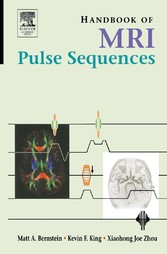Suchen und Finden
Handbook of MRI Pulse Sequences
This indispensable guide gives concise yet comprehensive descriptions of the pulse sequences commonly used on modern MRI scanners. The book consists of a total of 65 self-contained sections, each focused on a single subject. Written primarily for scientists, engineers, radiologists, and graduate students who are interested in an in-depth understanding of various MRI pulse sequences, it serves readers with a diverse set of backgrounds by providing both non-mathematical and mathematical descriptions.
The book is divided into five parts. Part I of the book describes two mathematical tools, Fourier transforms and the rotating reference frame, that are useful for understanding MRI pulse sequences. The second part is devoted to a wide variety of radiofrequency (RF) pulses, and the third part focuses on gradient waveforms. Data acquisition, image reconstruction, and physiological monitoring related to pulse sequence design form the subject of Part IV of the book. Once this foundation is established, Part V of the book describes the underlying principles, implementation, and selected applications of many pulse sequences commonly in use today.
The extensive topic coverage and cross-referencing makes this book ideal for beginners learning the building blocks of MRI pulse sequence design, as well as for experienced professionals who are seeking deeper knowledge of a particular technique.
?Explains pulse sequences, their components, and the associated image reconstruction methods commonly used in MRI
?Provides self-contained sections for individual techniques
?Can be used as a quick reference guide or as a resource for deeper study
?Includes both non-mathematical and mathematical descriptions
?Contains numerous figures, tables, references, and worked example problems
Alle Preise verstehen sich inklusive der gesetzlichen MwSt.









